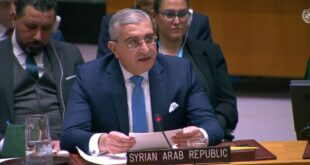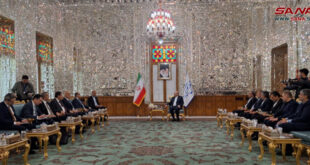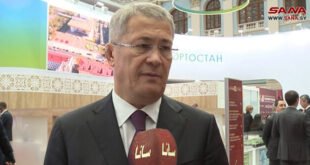Homs, SANA-The archeological hall at the Forty Martyrs Cathedral in Bustan al-Diwan neighborhood in Homs city center is considered as one of the most significant archaeological monuments in the city, and a living witness on the successive civilizations in Syria.
The hall’s building dates back to the year 1890 as it was established in vicinity of the Forty Martyrs Cathedral, and it was built on the ruins of the ancient great church which is the oldest church in Homs as it dates back to the fourth century A.D. when saint” Helena”, mother of Roman Emperor Constantine built a number of churches and monasteries and one of them was the cathedral which was demolished due to a devastating earthquake that stroke the city in 1159 A.D, according to Director of Al Ghassaniah Schools in Homs Murhaf Shahla.
Shahla added that the hall had been built with a unique architectural style which is distinguished by its artistic aesthetic elements as the hall expands over an area of about 160 square meters, and its roof was refined in a regular way while its walls were made of black basalt stones which Homs city is famous for. The basalt stone was a holy icon whose worship was connected with the Sun God who sent these stones according to what the locals had believed.
It is noteworthy that the historical and archeological importance of the hall stems from its location inside the walls of Homs Old City in Bustan al-Diwan neighborhood, in vicinity of the most ancient monasteries such as St. Julian al- Homsi Monastery, Um Al Zennar Church, Jesuit Fathers Monastery, and a number of old mosques such as the Great Mosque of al-Nuri, Abdul Hamid Al-Zahrawi Palace, the old roofed market, and the ancient Orthodox Al Ghassaniah schools.
The hall also has a social importance for the locals of the neighborhood as it has always received their social occasions.
Moreover, the hall opened its doors wide and for long years for artistic exhibitions, cultural and scientific seminars, poetry evenings, literary forums and a number of theatrical works, in addition to hosting dozens of educational activities and one of them was event performed by the children’s theater of Al Ghassaniah schools.
Shahla indicated that during the years of the terrorist war waged against Syria, the hall has maintained its cultural and social role, and this role has further increased after liberating the city in 2014, and it had been rehabilitated and prepared to open its doors after a year to receive al- Hamidiya Cultural Days which were organized by the Greek Orthodox Archdiocese of Homs and they included theatrical shows, artistic parties, cultural lectures and movie shows.
Nisreen Othman/ Ruaa al-Jazaeri
 Syrian Arab News Agency S A N A
Syrian Arab News Agency S A N A




